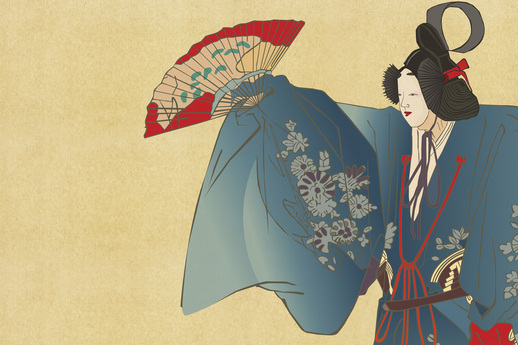2024.07.18
伝検通信(メルマガ)週刊メールマガジン「伝検通信」 第16号
週刊メールマガジン「伝検通信」第16号をお届けします。
今号のメインコンテンツは、神奈川県湯河原町立湯河原美術館で開かれている「旅する日本画―洋上の美術館・飛鳥Ⅲ」のレポートです。
「クイズで肩慣らし」は前回クイズの答え・解説と、芸能分野からの出題です。
メルマガ登録した方の中から、抽選で100人に公式テキストをプレゼントするキャンペーンも引き続き実施中です! ぜひお近くの方にメルマガ登録をご案内ください。
伝検公式テキスト
https://bookpub.jiji.com/book/
目次
・ 飛鳥Ⅲ、日本文化のキャラバンに =「旅する日本画」―湯河原で先行展覧会=
・ 「クイズで肩慣らし」第16回(芸能)=「能の形式」
・ 伝検協会だより
飛鳥Ⅲ、日本文化のキャラバンに=「旅する日本画」―湯河原で先行展覧会=

写真左/「旅する日本画」の作品について語る日本画家の平松礼二氏
写真右/「飛鳥Ⅲ」に展示される日本画が並ぶ町立湯河原美術館
(いずれも6月27日、神奈川県湯河原町)
2025年に就航予定の大型客船「飛鳥Ⅲ(あすかスリー)」の船内に展示される日本画家・平松礼二(ひらまつ・れいじ)氏の作品を先行公開する展覧会が9月23日まで、同氏が名誉館長を務める町立湯河原美術館(神奈川県湯河原町)で開かれている。「旅する日本画―洋上の美術館・飛鳥Ⅲ」と題し、日本の四季を描いた作品などを展示。平松氏は飛鳥Ⅲについて、「日本の伝統文化を丸ごと海外に持って行って国際交流を図るという『文化のキャラバン』のようなものだ」と語り、世界に向けた日本文化の発信に期待感を示した。
また、美術館を運営する同町の内藤喜文(ないとう・よしふみ)町長も「これまで美術館を訪れてくれたお客さんとは異なる客層の人にも興味を持ってもらえるまたとないチャンス。これを機に湯河原町に足を運んでもらいたい」と、地域のPRにつなげたい意向だ。
展覧会は「日本の四季」「モネの池」の2部で構成。日本の四季では、サクラの木々が濃淡のあるピンク色で鮮やかに描かれた「さくらの季(とき)」や、黄色、オレンジ、深紅のモミジの葉を題材にした「池に浮かぶ紅葉」など30作品が展示されている。
飛鳥Ⅲは総トン数5万2000トン、乗客定員約740人のクルーズ船。日本文化を伝える数多くの美術品や工芸作品を船内に展示するのが特徴だ。同船を保有・運航する郵船クルーズの河村洋(かわむら・ひろし)常務執行役員は「工芸作品などを展示できるように意識して設計した。まさに動く洋上の美術館だ」と、こだわりを強調する。
2000年から10年まで「文藝春秋」の表紙を担当し、花などを題材に創作活動を続ける平松氏が飛鳥Ⅲに提供する作品の制作テーマは「世界を旅する日本画」。このほか、船内には漆芸家で人間国宝の室瀬和美(むろせ・かずみ)氏ら多くの芸術家の美術品・工芸作品も飾られる。
平松氏の作品を先行公開する湯河原美術館は、夏目漱石が滞在したこともあるという老舗旅館を改装して1998年に開館。観光面だけでなく町の教育施設としての役割を担っているほか、サクラ、新緑、モミジなど四季折々の景色を楽しめる庭園に隣接したミュージアムカフェは町民の憩いの場にもなっている。内藤町長は「今後も観光振興のために活用していく」と力を込めた。
「クイズで肩慣らし」第16回(芸能)=「能の形式」
~伝検公式テキスト(9月20日先行発売予定)のジャンルごとに出題します~

月岡耕漁(つきおか・こうぎょ)作・能楽図絵「井筒」の模写
第16回
問題:世阿弥が確立した能の劇形式で、「井筒」などに代表される神霊や過去の幽霊など霊的な存在が主人公となる形式を「( )能」と言います。( )に入る言葉は何でしょう。
【前回の答えと解説】
問題:7月7日の「七夕」は五節句の一つ。五節句にはそれぞれ「行事食」があります。行事食とは、行事やお祝いの日に食べる特別な料理のことをいいます。七夕の行事食は何でしょう。
答え:素麺(そうめん)
解説:古代中国で7月7日に熱病で亡くなった皇子が悪霊となり熱病をはやらせたのを、好物だった「索餅(さくべい)」という菓子を供えて鎮めたという話が日本に伝わり、七夕の儀式に供え物の一つとして索餅が使われたことがルーツといわれています。その後、同じ小麦粉で作られた素麺が食べられるようになり、以来、無病息災を願う七夕の行事食となりました。また「五節句」が「五節供」と言われるのは、神前にお供え物をする節句の風習が由来とされています。
伝検協会だより
受験希望者向け「伝検協会指定参考書(ウェブサイト)」。伝統文化・伝統産業の基本を学ぶにはもってこいの素材を集めながら、その拡充に取り組んでいます。先週からは、新たに「歌舞伎美人(かぶきびと)」が加わりました。伝検協会の正会員である松竹が運営するサイトで、歌舞伎について初心者の方にも分かりやすく解説しています。「歌舞伎のアレコレ豆知識」のコーナーでは、歌舞伎の歴史、舞台、音楽、衣裳などを学べます。
参考書の一覧はこちら
https://denken-test.jp/
編集後記
伝検通信第16号はいかがでしたか。七夕の行事食が素麺とは知りませんでした。じわりと夏風邪や新型コロナウイルス感染症がはやっているようです。邪気退散で私も麺類をたくさん食べることにしました。伝検協会がある東銀座、近くの新富町、築地あたりにはラーメン、そば、うどんなどの名店があり目移りします。皆様もどうか夏バテ対策で暑さに負けない食生活を。
カテゴリー: 伝検通信(メルマガ)





